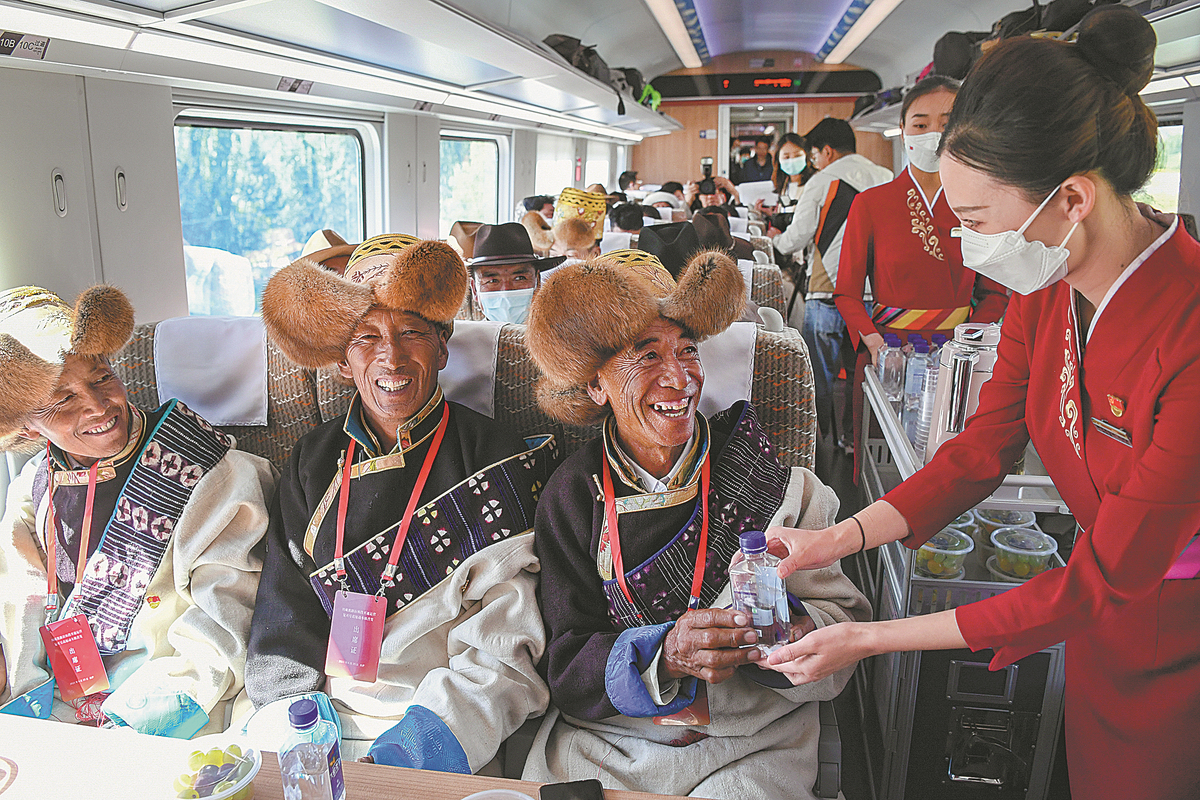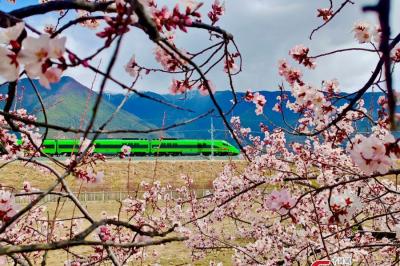 Tibetan passengers take a Fuxing bullet train on the Lhasa-Nyingchi Railway on June 25, 2021, the day the railway opened. The Lhasa-Nyingchi line, part of the Sichuan-Tibet Railway, links cities on the plateau and has improved local residents' livelihoods. [PURBU ZHAXI/XINHUA]
Editor's note: In this series, China Daily looks at some of the areas in which major progress has been made in the 10 years since the 18th National Congress of the Communist Party of China was held in November 2012.
Railway in Southwest China key to western development and national unity
When Tashi Tsering, a farmer in the Tibet autonomous region, makes the long trip to visit one of his daughters, he now prefers going by train.
The journey by rail rather than road is not only cheaper, but is much more convenient and pleasant, too, said Tashi Tsering, who lives in the city of Lhokha, which first got rail service a year ago.
The enjoyable journey was made possible when the Lhasa-Nyingchi Railway began operating in June last year.
With a length of 435 kilometers and a design speed of 160 km/h, the Lhasa-Nyingchi Railway links Lhasa, the capital of the autonomous region, with the southeastern cities of Nyingchi and Lhokha.
Multilingual service
"I have taken the train a few times now," Tashi Tsering said. "Every time, I enjoy the feeling on the train, where broadcasts of safety reminders and instructions to passengers are in three languages-Tibetan, Mandarin and English. I can easily understand all the information in my own language-Tibetan."
"The attendants are so nice, and the broadcast voice is so beautiful that every time I go, I don't want to get off the train, even when I arrive at my destination," the 66-year-old farmer added with a laugh.
The cost of a bus or van ticket for the trip from the part of Lhokha where Tashi Tsering lives to the town in Lhokha where his daughter resides is around 60 yuan ($9), while the fare for a regular seat on the train is only 11 yuan. The trip by train is also much quicker.
"It takes me about four hours to travel by a motor vehicle to Tsethang, the town where my daughter lives. By train, I can get there in 90 minutes," Tashi Tsering said, adding that the train is safe and comfortable, too.
"I can have a cup of hot water or buy some snacks from the shop on the train at any time," he said. "The attendants on the train are also very considerate. If a passenger does not feel well or needs a helping hand, they show up immediately."
Trains operate between Lhasa and Nyingchi every day between 8 am and around 6 pm.
The Lhasa-Nyingchi rail line is an operational section of the Sichuan-Tibet Railway, which is still under construction. It brings single-line electrified rail service, which uses an overhead line to provide electricity to run the trains, to the plateau for the first time. As a result, Fuxing bullet trains, the fastest in China, now run throughout the nation.
Ma Yong, vice-general manager of the China Railway Qinghai-Tibet Group, said that thanks to the Lhasa-Nyingchi line, the travel time between Lhasa and Lhokha has been reduced from more than two hours by road to about 60 minutes by rail, and the travel time between Lhasa and Nyingchi has been cut from about five hours to three-and-a-half.
The opening of the line not only ended the lack of access to rail service in southeastern Tibet, but also "further improved the entire Tibet autonomous region's comprehensive transportation system", Ma said.
"It has greatly contributed to the stability and accessibility of transportation in the region," he added.
Since beginning operations a year ago, the Lhasa-Nyingchi Railway has transported about 1.14 million passengers and hauled 47,800 metric tons of cargo, according to China State Railway Group.
 Engineers and technicians lay tracks for the Lhasa-Nyingchi Railway in 2020. Construction work on the rail line was an arduous task because of the complex geological conditions on the plateau. [CHOGO/XINHUA]
Sonam Wangdrak, who comes from Lhorong county in the city of Chamdo in Tibet and has been a locomotive driver for 15 years, is pleased to have the opportunity to work in Tibet.
He also hopes that access to rail service will continue to expand in Tibet.
Sonam Wangdrak recalled that, while in a primary school class three decades ago, he saw a picture of a train and made up his mind to work hard in school so he could one day be a locomotive engineer.
In 2003, he enrolled in Lanzhou Railway Machinery School in Northwest China's Gansu province and studied there for four years.
In 2007, he began an internship with China Railway Qinghai-Tibet Group in Qinghai province, which neighbors Gansu, and became a qualified engineer in 2012.
Last year, Sonam Wangdrak received a license to drive Fuxing bullet trains in Tibet, and now he works on the Lhasa-Nyingchi rail line.
"When I was a boy, villagers in my hometown might not have had a chance to even see a train. Now I have become an engineer," he said proudly.
"I believe that in a few years my hometown, Chamdo, in east Tibet will have rail access, and I dream that one day I will be able to go home by train," he added.
Fu Xiaoge, 26, who is from Northeast China's Liaoning province, began working as chief conductor for the Lhasa-Nyingchi rail in November.
"The opening of the rail is a historic event, and I want to make my own contribution to the development of Tibet while I am young," Fu said.
Upon graduation from a vocational school in Central China's Hunan province, she applied for a job on the Lhasa-Nyingchi rail line, having knowledge of Tibet that she learned from her father.
She knew about "the grand Potala Palace, Jokhang Temple, the snowcapped mountains and the yak herds", Fu said.
Initial difficulties
She said that she is honored to work in the plateau region, although at first she experienced difficulty breathing, which was followed by altitude sickness, including headaches and bleeding from the nose.
Having no command of the Tibetan language, Fu initially had difficulty communicating with the local residents.
"But as time goes by, I now understand them better, from their facial expressions and gestures, and I try my best to help them," she said.
Fu often feels homesick, as she has not visited her parents, who are more than 4,000 km away, for a year.
"But I overcome all these difficulties by thinking of my work, responsibility and mission," she said.
Meanwhile, rural residents in Tsikrak, a village in Nyingchi, have benefited from the rail line, which passes within one kilometer of the village. Now they no longer need to venture far from the village for part-time jobs.
Forty of the village's 292 residents work at the Nyingchi Railway Station.
Anyu, one of the villagers, said that most residents of the village do farm work, while most young villagers go to other places for part-time jobs throughout the year, and the elderly mostly stay in the village.
"After graduating from college in 2021, I started to work as a security inspector at the Nyingchi train station," said Anyu, 23.
"As my Mandarin is fluent, I have now become the team leader for security inspection at the station," she said.
 A Fuxing bullet train makes a trial run on the Lhasa-Nyingchi Railway in Lhokha, Tibet, before the rail line was put into operation. It is the first electric railroad on the plateau. [CHOGO/XINHUA]
From July 21 to 23 last year, President Xi Jinping visited the Tibet autonomous region for the 70th anniversary of the region's peaceful liberation, the first time that a top Chinese leader took part in such a celebration.
On July 22, Xi went to the Nyingchi Railway Station to learn about the overall design of the Sichuan-Tibet Railway and the operation of its Lhasa-Nyingchi section, and then the president took a train to Lhasa.
He said that building the Sichuan-Tibet Railway is a significant step in promoting Tibet's development and improving local people's livelihoods.
Given the complex topography and climate conditions and great difficulties in constructing the section between Ya'an in Sichuan province and Nyingchi, Xi stressed the need to allow technological innovation to play a key role in the process and to stick to scientific, safe and green construction of the landmark railway.
Due to the many rivers and mountains along the rail line's route, construction of numerous bridges and tunnels was required, and these account for about 75 percent of the line. The potential for landslides, earthquakes and heavy snow in the area also challenged the line's builders.
Yang Hao, a professor of rail transportation management at Beijing Jiaotong University, said the Lhasa-Nyingchi Railway, as a pilot project of the Sichuan-Tibet Railway, is a major traffic channel for Tibet's southeastern areas. It is therefore significant to the country's western development, regional economy and national unity, he said.
Yang said that the challenges of the project are reflected in the construction of the line's bridges and tunnels.
Expertise demonstrated
"Because the rail line cuts through complex geological conditions such as valleys and high mountains, the project is much more difficult than the Qinghai-Tibet Railway," he said, adding that the Sichuan-Tibet Railway is the most arduous railway project in China.
Yang said the line also reflects the country's expertise in railway construction in plateau regions.
As the second major traffic channel connecting Tibet with the rest of China-the first is the Qinghai-Tibet Railway, which began operations in 2006-the Sichuan-Tibet Railway forms a grid offering greater accessibility, flexibility and reliability in the rail and road network, and it has created wider coverage of services to benefit residents, Yang added.
"It has further improved the railway network in China's western regions," he said. "It is of great value in making the economic and cultural ties closer between the Tibet autonomous region and the rest of China."
By PALDEN NYIMA in Lhasa |
- Home
- News Tibet |Exclusive |China |World |Related News |Latest
- Documents White Papers |Others
- Photo Politics |Economy & Society |Culture & Religion |Human & Nature |Beautiful Tibet |Other Tibetan-Inhabited Area |Exchanges |Related
- Video News |Documentary |Micro-Video |Entertainment
- Art
- Tourism
- In Focus
- About Tibet






